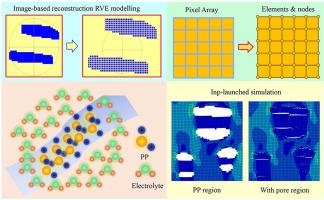当前位置:
X-MOL 学术
›
Mech. Mater.
›
论文详情
Our official English website, www.x-mol.net, welcomes your
feedback! (Note: you will need to create a separate account there.)
Modelling electrolyte-immersed tensile property of polypropylene separator for lithium-ion battery
Mechanics of Materials ( IF 3.4 ) Pub Date : 2021-01-01 , DOI: 10.1016/j.mechmat.2020.103667 Weigui Xie , Lin Wu , Wangyu Liu , Yanping Dang , Aimin Tang , Yuanqiang Luo
Mechanics of Materials ( IF 3.4 ) Pub Date : 2021-01-01 , DOI: 10.1016/j.mechmat.2020.103667 Weigui Xie , Lin Wu , Wangyu Liu , Yanping Dang , Aimin Tang , Yuanqiang Luo

|
Abstract Lithium-ion batteries have grown into remarkable energy resource thanks to the superior power and specific energy densities, astounding cycling performance, green sustainability, and extensive applicability. As an important component, the mechanical properties of separator notably affect the assembly quality and working safety of the battery. In this paper, aiming at the electrolyte-immersed and rate-dependent tensile properties of Polypropylene (PP) separators, comprehensive tensile tests concerning different circumstances are conducted. And more significantly, a representative volumetric element (RVE) modelling method is proposed, which is based on image reconstruction technique and realized through inp-launched finite element simulation. The essence of RVE modelling is straightly converting image pixels to finite elements with patterned nodes. The electrolyte immersion effect on PP material is explored through molecular simulation. The experimental results indicate that tensile behaviors are rate dependent and electrolyte immersion would lead to considerable weakening to PP separators. Therefore, mechanical properties of "wet" separators should be seriously considered in future designing. The simulation has successfully calculated the Young's modulus of the PP separators, which inspiringly agrees to that of the experimental. The modelling precision is reliable and the simulating errors are relatively small, revealing worthy applicability and promising outlook of the modelling method.
中文翻译:

锂离子电池聚丙烯隔膜电解液拉伸性能建模
摘要 锂离子电池由于具有优越的功率和比能量密度、惊人的循环性能、绿色可持续性和广泛的适用性,已成为一种卓越的能源资源。隔膜作为电池的重要组成部分,其机械性能显着影响电池的组装质量和工作安全。在本文中,针对聚丙烯(PP)隔膜的电解质浸渍和速率相关拉伸性能,针对不同情况进行了综合拉伸试验。更重要的是,提出了一种代表性体积元(RVE)建模方法,该方法基于图像重建技术,通过inp发射的有限元仿真实现。RVE 建模的本质是将图像像素直接转换为具有图案节点的有限元。通过分子模拟探索电解质对PP材料的浸入效应。实验结果表明,拉伸行为取决于速率,电解液浸泡会导致 PP 隔膜显着弱化。因此,在未来的设计中应认真考虑“湿”隔板的机械性能。模拟成功计算了 PP 隔膜的杨氏模量,与实验结果一致。建模精度可靠,仿真误差较小,表明该建模方法具有较好的适用性和广阔的前景。通过分子模拟探索电解液对PP材料的浸入效应。实验结果表明,拉伸行为取决于速率,电解液浸泡会导致 PP 隔膜显着弱化。因此,在未来的设计中应认真考虑“湿”隔板的机械性能。模拟成功计算了 PP 隔膜的杨氏模量,与实验结果一致。建模精度可靠,仿真误差较小,表明该建模方法具有良好的适用性和广阔的前景。通过分子模拟探索电解液对PP材料的浸入效应。实验结果表明,拉伸行为取决于速率,电解液浸泡会导致 PP 隔膜显着弱化。因此,在未来的设计中应认真考虑“湿”隔板的机械性能。模拟成功计算了 PP 隔膜的杨氏模量,与实验结果一致。建模精度可靠,仿真误差较小,表明该建模方法具有较好的适用性和广阔的前景。在未来的设计中应认真考虑“湿”隔板的机械性能。模拟成功计算了 PP 隔膜的杨氏模量,与实验结果一致。建模精度可靠,仿真误差较小,表明该建模方法具有较好的适用性和广阔的前景。在未来的设计中应认真考虑“湿”隔板的机械性能。模拟成功计算了 PP 隔膜的杨氏模量,与实验结果一致。建模精度可靠,仿真误差较小,表明该建模方法具有较好的适用性和广阔的前景。
更新日期:2021-01-01
中文翻译:

锂离子电池聚丙烯隔膜电解液拉伸性能建模
摘要 锂离子电池由于具有优越的功率和比能量密度、惊人的循环性能、绿色可持续性和广泛的适用性,已成为一种卓越的能源资源。隔膜作为电池的重要组成部分,其机械性能显着影响电池的组装质量和工作安全。在本文中,针对聚丙烯(PP)隔膜的电解质浸渍和速率相关拉伸性能,针对不同情况进行了综合拉伸试验。更重要的是,提出了一种代表性体积元(RVE)建模方法,该方法基于图像重建技术,通过inp发射的有限元仿真实现。RVE 建模的本质是将图像像素直接转换为具有图案节点的有限元。通过分子模拟探索电解质对PP材料的浸入效应。实验结果表明,拉伸行为取决于速率,电解液浸泡会导致 PP 隔膜显着弱化。因此,在未来的设计中应认真考虑“湿”隔板的机械性能。模拟成功计算了 PP 隔膜的杨氏模量,与实验结果一致。建模精度可靠,仿真误差较小,表明该建模方法具有较好的适用性和广阔的前景。通过分子模拟探索电解液对PP材料的浸入效应。实验结果表明,拉伸行为取决于速率,电解液浸泡会导致 PP 隔膜显着弱化。因此,在未来的设计中应认真考虑“湿”隔板的机械性能。模拟成功计算了 PP 隔膜的杨氏模量,与实验结果一致。建模精度可靠,仿真误差较小,表明该建模方法具有良好的适用性和广阔的前景。通过分子模拟探索电解液对PP材料的浸入效应。实验结果表明,拉伸行为取决于速率,电解液浸泡会导致 PP 隔膜显着弱化。因此,在未来的设计中应认真考虑“湿”隔板的机械性能。模拟成功计算了 PP 隔膜的杨氏模量,与实验结果一致。建模精度可靠,仿真误差较小,表明该建模方法具有较好的适用性和广阔的前景。在未来的设计中应认真考虑“湿”隔板的机械性能。模拟成功计算了 PP 隔膜的杨氏模量,与实验结果一致。建模精度可靠,仿真误差较小,表明该建模方法具有较好的适用性和广阔的前景。在未来的设计中应认真考虑“湿”隔板的机械性能。模拟成功计算了 PP 隔膜的杨氏模量,与实验结果一致。建模精度可靠,仿真误差较小,表明该建模方法具有较好的适用性和广阔的前景。











































 京公网安备 11010802027423号
京公网安备 11010802027423号